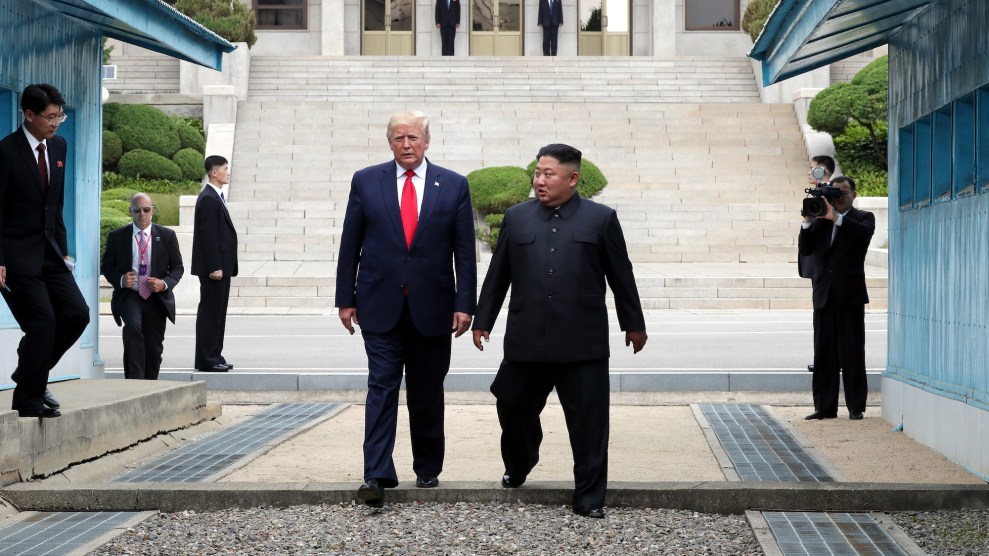
A handout photo provided by Dong-A Ilbo of North Korean leader Kim Jong Un and U.S. President Donald Trump inside the demilitarized zone (DMZ) separating the South and North Korea on June 30, 2019 in Panmunjom, South Korea.Handout/Dong-A Ilbo/Getty Images
President Donald Trump’s short Sunday stroll into North Korea with Kim Jong Un, that country’s leader, represented perhaps the apotheosis of Trump’s personal form of dictator diplomacy.
It was a typically Trumpian display of theatrics: He became the first sitting American president to set foot on North Korean soil, offering symbolism with only the shakiest promises of policy follow-through. It was, in short, a camera-ready display of friendship to an autocrat in exchange for little but a pledge to talk more.
“Big moment, big moment,” Trump told Kim, as cameras whirred and journalists jostled.
The result: Trump and Kim agreed to resume talks on a nuclear deal. But there is little to indicate that Kim, having just pocketed the prized legitimation conferred by standing as an apparent equal with the US president, will take serious steps to scale back the nuclear program he already possesses.
JUST IN: Asked if he'd invite Kim Jong Un to the US, President Trump says, "I would invite him right now – to the White House, absolutely." https://t.co/FtT6leBRIX pic.twitter.com/8Ev01Luwhv
— NBC News (@NBCNews) June 30, 2019
“We’ve seen a history here, especially in this case, where Donald Trump announces these summits and nothing really comes out it, said Sen. Amy Klobuchar (D-Minn.), a presidential candidate, adding that Americans want to see the Korean peninsula denuclearized. “It’s not as easy as just going, and… bringing a hot dish over the fence to the dictator next door,” she said. “This is a ruthless dictator and when you go forward you have to clear focus and a clear mission and clear goals. And that has been our problem so far.”
Sen. Bernie Sanders (I-Vt.), another presidential candidate said Sunday on ABC’s “This Week” that he had “no problem” with Trump’s visit, but “I don’t want it simply to be a photo opportunity.”
Trump’s move has drawn some criticism from the right too, but nothing like the conservative freak-out caused by President Barack Obama’s 2008 statement that he was willing to talk to North Koreans “without preconditions.”
“This is the way he does diplomacy,” said former New Jersey Governor Chris Christie, a Trump ally, also on “This Week.” Now we’re gonna see if it’s going to work.” Christie said that it’s possible “nothing will work with North Korea,” but argued that previous approaches have also failed.
This is a common talking point. But previous policies pursued by the US with allies have in some way constrained, without fully halting, North Korea’s nuclear production. A so-called “Agreed Framework” deal in 1994 succeeded in temporarily freezing North Korea’s plutonium production by allowing international inspections of the country’s reactors. North Korea was later revealed to have secretly pursued a uranium enrichment program, but the agreement substantially slowed North Korea’s efforts to build a bomb.
Between 2003 and 2009, the so-called Six-Party Talks prevented North Korea from unrestrained efforts to build a weapon, though the talks failed to produce a final deal.
The best hope now that Trump’s walk into North Korea produces anything but photographs will come if it leads to the resumption of negotiations likely, at best, to have similarly frustrating and imperfect outcomes. But that would require a president with the discipline and tolerance for diplomatic complexity.
















